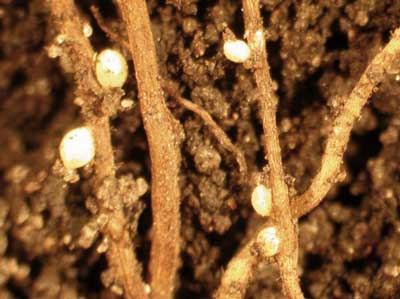- The soybean cyst nematode is the most economically damaging pest of soybeans in the US.
- Soil and root sampling are the most accurate way to detect SCN presence in a field.
- Soil sampling helps determine how much loss is due to SCN or if a management practice is reducing SCN populations over time.
- SCN can be managed but not eradicated.
This is the first article of a series on SCN sampling and management.
SCN damage and symptoms
The soybean cyst nematode (SCN), Heterodera glycines, causes greater losses than any other soybean pathogen in the U.S, with annual yield losses estimated at more than $1 billion. Yield losses can vary from year to year and are influenced by soybean variety, weather conditions, soil type and other plant stressors. SCN damage soybeans by interfering with root growth and consequently disrupting water and nutrient uptake, nodulation and nitrogen fixation and soybean growth. SCN can also cause indirect damage to soybeans by making the roots more susceptible to secondary infection by other fungal pathogens, like sudden death syndrome. Symptoms are not always visible and infections can go undetected for several years. When present, symptoms of SCN often include stunting and yellowing of the crop. However these symptoms are not diagnostic as they can also be associated with other pests, pathogens, drought or excess water, nutrient deficiencies etc. For these reasons, it is important for growers to learn how to properly sample, identify and manage SCN.
Sampling
In order to manage SCN we first need to know how much SCN there is in a field. The best way to do that is to have soil assessed for the abundance of SCN eggs in the soil. Although assessment of SCN egg populations can be done at any time of year, the best and easiest time to collect samples is immediately after harvest when you are out in the field collecting fertility samples. A good general recommendation is to take half of the soil collected and send it off to a clinic for SCN egg quantification, and the other half for soil nutrient assessment.
Why is it important to know how many SCN you have in a field? In general soybean yields decline as the number of SCN eggs increase. The higher the egg numbers, the more likelihood for root growth to be affected. Eggs are contained within the cyst, the lemon-shaped mature female, overwinter and begin hatching in the spring. One cyst may contain up to 400 eggs that can remain viable for 12 years or more.
The most accurate way to sample for SCN is randomly collect soil samples across the field that contain soybean root fragments. Sample after fall harvest but before tilling the ground. Each sample should be a composite of at least 20-30 cores 8-10” deep, taken within the rows. For large fields, collect samples from at least two random 5-acre sections with similar soils and history. A general guideline is to have fields assessed for SCN at least every 5 years. If testing a new SCN management strategy, shorter sampling intervals are preferred.
Management
Remember that SCN can be managed, but not eradicated. The goals for managing SCN include the reduction of SCN infestation levels so as to improve soybean yields. Management practices include:
- Host resistance: SCN densities tend to decrease when resistant varieties are grown because SCN is unable to feed and develop on their roots. Although most populations of SCN are now able to grow on PI88788 derived resistance, their growth and development is still slower than on cultivars lacking resistance. Rotate resistance sources or cultivars.
- Rotation to nonhost crops: SCN numbers will decline when nonhost crops are grown as SCN is unable to develop and reproduce in the absence of host roots. Good rotational crops include corn and sorghum
- Cultural: Ensuring that plants are growing optimally and rapidly will help offset limitations imposed by SCN feeding.
- Seed treatments: SCN goes through many lifecycles and does not start to become active until soils have warmed to a considerable extent. For this reason, early planted soybeans are less likely to benefit from a nematastat/cide seed treatment as opposed to later planted soybeans. This is because the seed treatment on later treated soybeans is more likely to come into contact with active SCN nematodes. Inactive SCN are protected by cysts and unlikely to encounter active nematistat/cidal compounds by the time they hatch when soils warm.

Picture 1: Soybean cyst nematode on soybean roots (Source: GROWMARK, Inc.)